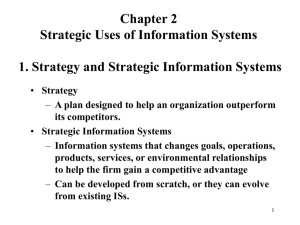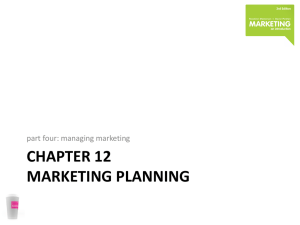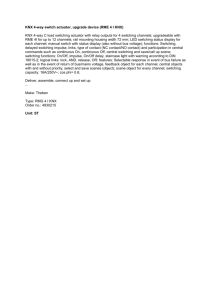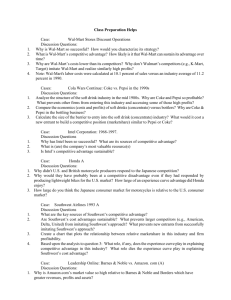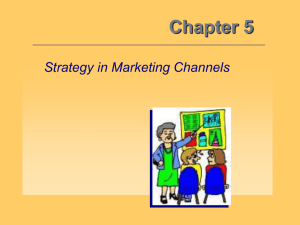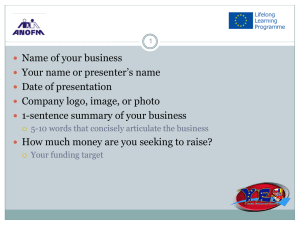Management Information Systems
advertisement
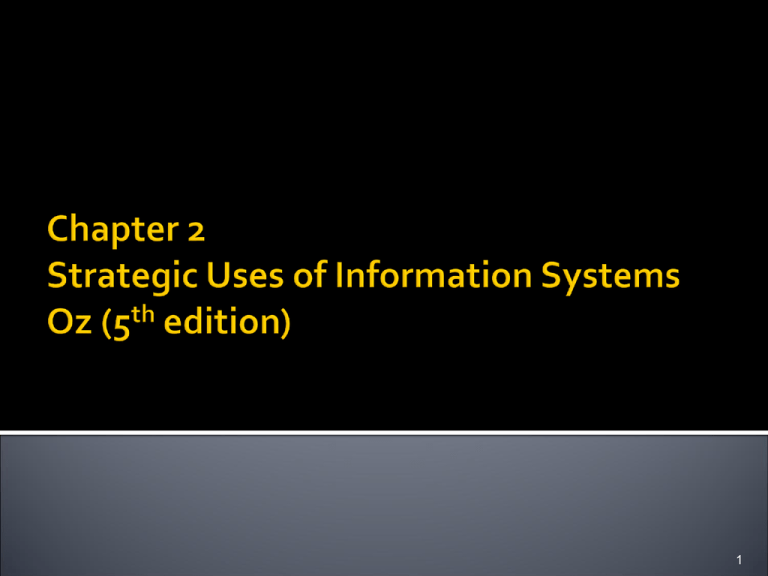
1 Strategy A plan designed to help an organization outperform its competitors. Strategic Information Systems Information systems that changes goals, operations, products, services, or environmental relationships to help the firm gain a competitive advantage Can be developed from scratch, or they can evolve from existing ISs. 2 Strategies for this type of company involve increasing profits Reduce costs Increase revenue through a larger market share Do both The essence of strategy is innovation, so competitive advantage often occurs when an organization initiates a strategy that no one has tried before. Dell’s use of the Web to take customer orders Citibank’s use of ATMs Airlines use of computerized reservation systems 3 1. 2. 3. 4. Operational excellence: Wal-Mart New products, service, or business models: Netflix, Apple’s iPod and iTunes Customer and supplier intimacy: effective CRM and SCM Improved decision making GIS Data mining CRM Mathematical modeling in DSS applications 4 Strategies and Initiatives 5 Figure 2.2 Many strategic moves can work together to achieve a competitive advantage 6 Initiative #1: Reduce Costs (1, 3, & 4) Lower Costs enable you to lower your prices Competitors may not be able to follow your lead; thus you gain market share Examples: ▪ Dell’s ability to continually lower cost of PCs through improving their supply chain and taking orders online ▪ Wal-Mart use of SCM (vendor replenishment) cuts their operational costs ▪ On-line services (FAQ, package tracking) 7 Initiative #2: Raise Barriers to Entrants (2) Patenting ▪ Microsoft's programs ▪ Lotus’s 1-2-3 ▪ Priceline.com’s reverse auction ▪ Amazon.com’s one-click shopping ▪ Patented features of Apple’s IPod; sell music from big labels on Apple’s web site High expense of entering industry ▪ State Street, Inc. (Pension fund management business); money required to build systems keeps competitors out of this market; rents its software to others 8 Initiative #3: Establish High Switching Costs (2 or 3) Explicit switching costs are fixed and nonrecurring ▪ Penalties for canceling cell phone provider ▪ Use of proprietary products (operating systems;tape formats;DVD formats) ▪ Use of IS/IT in customer loyalty programs (e.g., grocery stores, retailers) Implicit Switching Costs ▪ Indirect costs in time and money of adjusting to a new product ▪ Changing application software (MS Office to Sun’s StarOffice) 9 Initiative #4: Create New Products and Services This advantage lasts only until other organizations in the industry start offering an identical or similar product or service for a comparable or lower price. (2) Examples ▪ FedEx’s package tracking ▪ Levi’s “personal pair” ▪ eBay ▪ ATM’s from Citibank ▪ Custom computers from Dell Fleeting advantage (Netscape and Internet Explorer) First mover success; critical mass 10 Initiative #5: Differentiate Products and Services (2, 3) Persuade customers that your product is better than your competitors ▪ Brand recognition such as Levi’s, Chanel, or Calvin Klein Use of the Internet to differentiate ▪ Email ▪ Answering questions online ▪ Purchasing advice online ▪ Personalize the Web page (Amazon.com) ▪ Easy to use Web site IBM’s transformation to a consulting company 11 Initiative #6: Enhance Products and Services (similar to #5) (2 and 3) Examples ▪ Dell offers a buying guide to differentiate itself from other online sellers ▪ Charles Schwab moving stock trading services on-line before Merrill Lynch ▪ Web enables companies to continually enhance services 12 Initiative #7: Establish Alliances that links your IS with a partner’s IS (3) Combined service may attract customers ▪ Lower cost ▪ Convenience Examples ▪ Travel industry ▪ HP and FedEx ▪ Affiliate programs ▪ Amazon’s relationship with Target and other retailers 13 Initiative #8: Lock in Suppliers or Buyers (similar to high switching costs) (3) Lock in suppliers ▪ Bargaining power of buyer is determined by purchase volume (systematic sourcing) ▪ Wal-Mart Lock in buyers ▪ Create impression of product superiority ▪ High switching costs ▪ Create a standard (software industry) ▪ Microsoft ▪ Adobe (gave away the reader but sells the writer); Macromedia 14 Top management involvement From initial consideration through development and implementation Must be a part of the overall organizational strategic plan 15 16 Implementation of an SIS often results in organizational change (sometimes unplanned) Planned organizational change is often referred to as “reengineering” Actively seek ways to employ IT to gain large leaps in efficiencies Different from continuous improvement Often associated with large job losses. Reengineering projects have high failure rates GM’s Saturn division How did GM approach this? Why did they do it this way? 17 Success: JetBlue (you fill in the details) Use of IT Change in internal processes Enhanced customer service Late mover advantage Failure: Ford (you fill in the detail) ConsumerConnect (replaced by FordDirect) Covisint 18 Easy Reduce cost Differentiate product/service Enhance product/services Establish alliances Hard Raise barriers to entrants Lock in buyers or suppliers Establish high switching costs Create new product/service 19 Business owners must develop new features to keep the system on the leading edge. Adopting a new technology involves great risk. No experience from which to learn No guarantee technology will work or customers and employees will welcome it Some organizations let competitors assume the risk associated with being on the leading edge. Risk losing initial rewards. Can quickly adopt and even improve pioneer organization’s successful technology (Microsoft) Home Depot’s use of a data warehouse 20 Competitive advantage is difficult to sustain In some industries, companies must continually contemplate new ways of utilizing IS/IT for competitive advantage Many strategic systems have been unplanned and often come from transaction processing systems You cannot depend on your IS/IT department as your sole source of ideas for strategic use of IS/IT Strategic systems often become standard business procedures (e.g., ATMs, bank by phone) Personal competitive advantage 21
